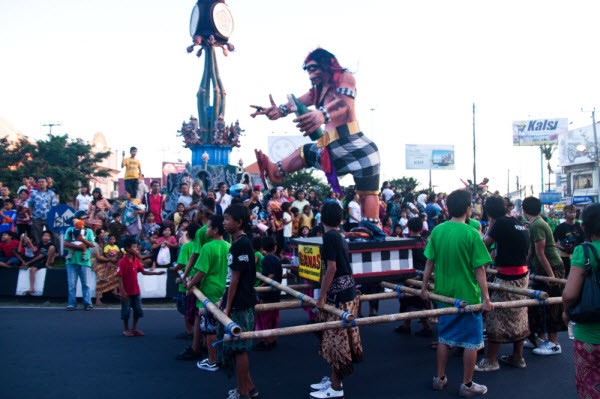Ashlee Betteridge is an Australian freelance journalist who has been based in Indonesia for 1.5 years.
Ashlee writes: Tuesday (March 16) was Bali’s day of silence, known as Nyepi. Marking the Saka New Year on the predominantly Hindu island, the holiday means that streets are unusually empty. Tourists are locked inside their hotels. Locals stay inside their homes abstaining from entertainment, cooking, travel or work, just meditating and contemplating their actions in the past and for the future.
Yep, that’s right. No sunburnt bogans wandering along Kuta Beach still drunk from the night before, even though its 4pm. No “transport misses, where you going?”. No Ubud new-age types teaching yoga to street kids in the foothills of the mountains. No beep beep beep of motorcycle horns. Just quiet.
The only people allowed on the streets are traditional security guards, who make sure everyone else stays inside. The airport is closed, the seaports are closed and emergency vehicles are the only ones allowed to pass, as long as they have the right permit. When night falls, the island will be blanketed in darkness. Even the signals for all the local television stations are switched off, and my hotel has covered its windows with cardboard so that guests can still use the lights in their rooms. All the Balinese staff are off work and its the migrants from Java who are dishing out the overpriced room service meals that we must survive on until 6 am Wednesday morning when Nyepi ends.
I came to the island from Jakarta especially for Nyepi. Some people may wonder why I would come on a Bali holiday to be locked up in a cheap hotel for 24 hours, eating an overpriced excuse for mie goreng (fried noodles).
Thankfully, there’s more to the celebration than that.
In the three or four days leading up to Nyepi, community groups travel to the sea or river for the Melasti ritual, a colourful purification ceremony. Arriving on trucks, motorbikes and on foot, bringing along sacred instruments, the pilgrimage to the sea culminates in hymns and prayers before sprinkling sea water on the statues, umbrellas and spears from the local temple to cleanse them before the new year.
The night before Nyepi, crowds of people take to the streets to see ogoh-ogoh, giant papier mache and bamboo sculptures of demons and devils that are constructed by community and youth groups over weeks. The scary giant craft projects, which are often amazingly detailed, are noisily paraded down streets and through the main intersections in towns and villages. The ogoh-ogoh, depicting either full scenes from the Hindu Ramayana epic or more contemporary scary creatures, are later burned.

One of the theories goes that the ogoh-ogoh parades and the burning of the effigies scares away the demons and bad spirits from the island. The next day, if the bad spirits come back, with everything silent and closed they will think Bali has been abandoned and will leave again for another year.
Others say the ogoh-ogoh and the offerings given on the day are a gift to the bad spirits, to appease them and ask for mercy, while the day of silence is a reminder of the beginnings of life and the universe.
Whatever take you prefer, the parades are spectacular to watch and the silence is refreshing.
But beyond my grandmother-esque obsession with quietness and a deep love for giant papier mache constructions fostered by watching Playschool and the Rock Eisteddfod on the TV as a kid, I also came to Bali this week for the rare chance to see a holiday that has not been swayed by commercialism.
Living in Indonesia where the major celebrations of all five state-recognized religions are observed, it often becomes a fun game to see the cheesiest holiday promotions around. Around Chinese New Year here, McDonald’s released the “Prosperity Burger” and the shopping malls made use of the new year falling on the same date as Valentine’s Day to decorate with super tacky Chinese-style bridges with love hearts hanging off them.
Last Christmas, at least three Jakarta malls had fake snow falling from their ceilings and one had a giant Spongebob Squarepants nativity scene.
In the lead up to Idul Fitri, the end of the Muslim fasting month of Ramadan, it is not uncommon to see mini-mosques constructed inside shopping centers full of wonderful food and gifts to buy for mudik, the Indonesian word for the annual exodus from the cities to the villages to spend the holiday with family. Television ads filled with pious-looking people blast out what you should eat to best break the fast.
The key message for most of these holidays? Spend, spend, spend. But Nyepi determinedly seems to escape all this.
It would be all too easy for the Balinese to relent to the whinging of tourists and let them bask in the island sun for another day, taking their rupiah in exchange for sarongs, massages and Bintang beers.
But tradition stands firm and on Nyepi, tourism and capitalism and everything else must sit still for once, just like everyone else on the island.
And in a 24-hour global economy in our networked hyperlinked world, that stillness and respect for tradition is something that’s becoming increasingly rare to see, making Bali at Nyepi worth the journey.







Crikey is committed to hosting lively discussions. Help us keep the conversation useful, interesting and welcoming. We aim to publish comments quickly in the interest of promoting robust conversation, but we’re a small team and we deploy filters to protect against legal risk. Occasionally your comment may be held up while we review, but we’re working as fast as we can to keep the conversation rolling.
The Crikey comment section is members-only content. Please subscribe to leave a comment.
The Crikey comment section is members-only content. Please login to leave a comment.